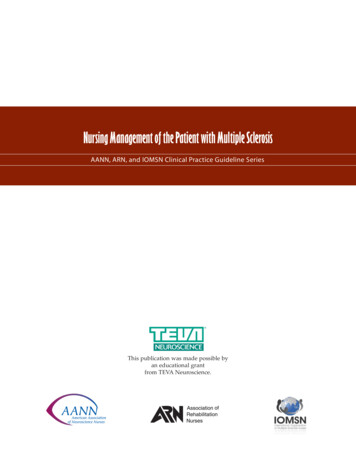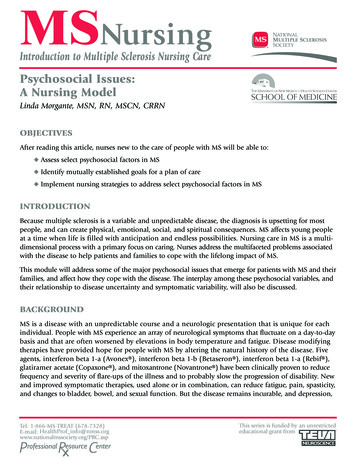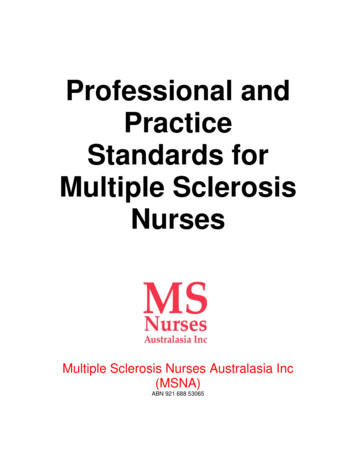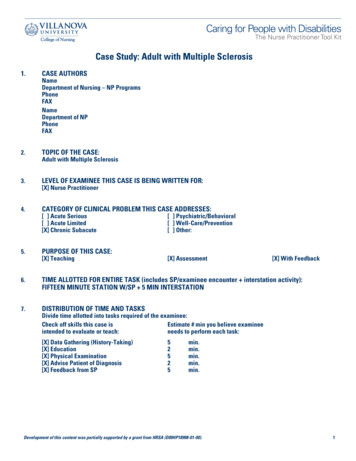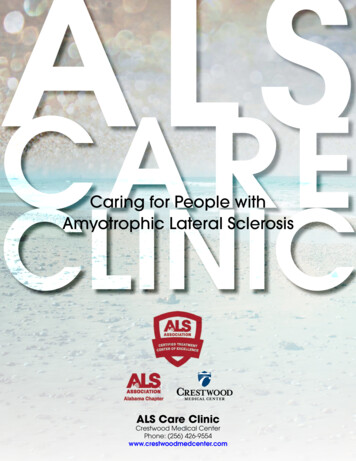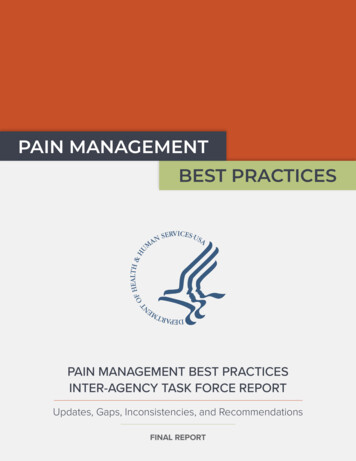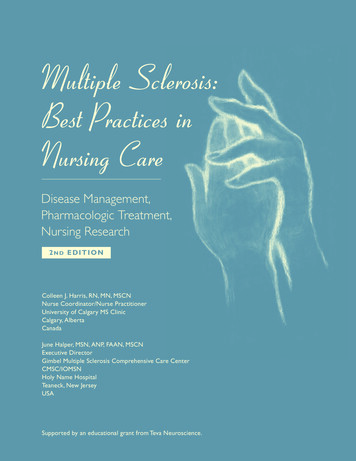
Transcription
Multiple Sclerosis:Best Practices inNursing CareDisease Management,Pharmacologic Treatment,Nursing Research2ND EDITIONColleen J. Harris, RN, MN, MSCNNurse Coordinator/Nurse PractitionerUniversity of Calgary MS ClinicCalgary, AlbertaCanadaJune Halper, MSN, ANP, FAAN, MSCNExecutive DirectorGimbel Multiple Sclerosis Comprehensive Care CenterCMSC/IOMSNHoly Name HospitalTeaneck, New JerseyUSASupported by an educational grant from Teva Neuroscience.
The opinions expressed in these materials are those of the authors and are not attributable to the publisher or educationalgrant provider. In weighing the benefits of treatment against the risks, physicians and nurses should be guided by clinicaljudgment. Dosages, indications, and methods for use of drugs and procedures referred to may reflect the clinical experience ofthe authors or may be derived from the professional literature or other clinical sources. Some of the uses and applications ofdrugs, devices, and techniques discussed herein may be outside of approved indications. Consult complete prescribinginformation before administering any of the drugs discussed.Ms. Harris has the following relationships to disclose: She has been or is a consultant to Berlex Laboratories, Biogen, Serono, andTeva Neuroscience, and she has received an educational grant from Berlex Canada.Ms. Halper has the following relationships to disclose: She has been or is a consultant to Teva Neuroscience and has participatedon speakers bureaus for Teva Neuroscience, Berlex Laboratories, and Serono/Pfizer.Some of the research cited in these materials may have been funded by the educational grant provider.Supported by an educational grant from Teva Neuroscience. 2004. All rights reserved.None of the contents of this publication may be reproduced in any form without the prior written consent of the publisher.
Multiple Sclerosis:Best Practices in Nursing CareDisease Management,Pharmacologic Treatment,Nursing Research2ND EDITIONTable of ContentsForeword2Introduction4Overview of Multiple Sclerosis5Symptoms and Diagnosis5Disease Classification6Evolution of Multiple Sclerosis Treatment and Nursing Practice8Developing a Model of Multiple Sclerosis Nursing Practice9Definition of a Multiple Sclerosis Nurse9Philosophy of Multiple Sclerosis Nursing Practice9Practice Areas9Practice Areas Across the Disease TrajectoryDomains and Competencies of Multiple Sclerosis Nursing1012Multiple Sclerosis Nursing Domains12Knowledge-Based Competencies12Skill-Based Competencies12Matching Nursing Competencies to Nursing Domains13Role of the Nurse in Pharmacologic Therapy of Multiple Sclerosis15Episodic Treatments15Symptomatic Treatments16Medications Used for Disease Modification19Supporting Multiple Sclerosis Nursing Practice Through Research25Limitations of Multiple Sclerosis Nursing Research26Strategies to Facilitate Nursing Research: Buying Time26Recommendations for Multiple Sclerosis Nursing Research28Research Priorities28Conclusion29References30
Multiple Sclerosis: Best Practices in Nursing CareForewordMultiple sclerosis (MS) has a major impact on the lives of patients and their families. Its unpredictable course leavesthose affected with an uncertain future. Recent advances in understanding about the disease and its treatment havechanged the way that healthcare professionals can help patients and their families. In addition to diagnosing and providing supportive care, treatment now can be directed toward changing the disease course. As a result, MS nursesworldwide are faced with many challenges as they meet the needs of patients in the rapidly changing field of MS.The MS Nurse Specialists Consensus Committee has drawn on research, educational, and practical experiences todevelop a new and cohesive model of nursing care in MS—one that will sustain and educate nurses in their clinicalpractice, promote nursing research, and inspire a new generation of MS nurses as they enter the field. This model isthe leitmotif of the International Organization of Multiple Sclerosis Nurses (IOMSN).A new definition of MS nursing follows. The MS nurse is a competent expert who collaborates with those affectedby MS and shares knowledge, strength, and hope. As the role of nurses continues to evolve, there is a need to establish a cohesive model of MS nursing practice along with specific standards for best practice in MS nursing care.Nursing practice aims to both manage and influence the patient’s illness by supporting disease-modifying treatments;facilitating symptoms management; promoting safe, maximal function; and supporting a wellness-oriented quality oflife. Activities that are essential to patient care can be grouped into: Establishing care Continuing care Sustaining careTogether, these interwoven areas provide a framework for a comprehensive, cohesive model for MS nursing practicethat can be applied to care of all MS patients, regardless of disease classification or level of disability.This monograph is an updated edition of the earlier version that was created by the Multiple Sclerosis Nurse Specialists Consensus Committee (see page 3 for a complete listing of Committee members, all of whom are nurses specializing in MS care), and now includes valuable new information. As with the previous edition, this monograph is designedto enhance MS nursing care, particularly with regard to disease management, pharmacologic treatment, and nursingresearch. The information herein was drawn from MS and nursing literature, research in MS and other chronic illnesses, and the years of experience of the distinguished participants in this project. This monograph will assist nursesin fulfilling their universal purpose of providing high-quality, compassionate care of patients and families affected by MS.Specifically, this publication is designed to help nurses:1. Describe the epidemiology and disease pathology of MS2. Explain how MS nursing is concomitant to the evolution in diagnostic technology and treatment approaches3. Identify domains in MS nursing4. Identify key competencies within each domain5. Identify the nurse’s various roles in caring for patients and families affected by MS6. Describe the context of MS nursing practice in optimizing MS treatments2
Disease Management, Pharmacologic Treatment, Nursing Research7. Describe medications used for acute, symptomatic, and disease modification in MS with nursingimplications8. Define evidence-based practice in MS nursing9. Describe limitations and gaps in MS research and proposed work to fill those gaps10. Identify potential sources of financial support for MS nursing researchWe hope the information provides a framework to support the sustained value of the work of nurses who arededicating their professional careers to the field of MS.Colleen J. Harris, RN, MN, MSCNNurse Coordinator/Nurse PractitionerUniversity of Calgary MS ClinicCalgary, AlbertaCanadaJune Halper, MSN, ANP, FAAN, MSCNExecutive DirectorGimbel Multiple Sclerosis Comprehensive Care CenterCMSC/IOMSNHoly Name HospitalTeaneck, New JerseyUSAMultiple Sclerosis Nurse Specialists Consensus Committee Wini Breitbach, RN, The Maxine Mesinger MS Clinic,Houston, Texas Emily Cerreta, MSN, RN, CNS, University of Texas,Houston, Texas Ismari M. Clesson, RN, CRRN, Multiple Sclerosis Centerat Shepherd, Atlanta, Georgia Kathleen Costello, RN, MS, CNRN, MSCN, University ofMaryland/VA MS Center of Excellence, Baltimore,Maryland (Group Leader) Andrea Censky Dietrich, MSN, BSN, Paralyzed Veteransof America, Washington, DC Cira Fraser, APRN, BC, MSCN, PhD, MonmouthUniversity/Maimonides MS Care Center, West LongBranch, NJ/Brooklyn, NY (Group Leader) Elida Greinel, APN-BC, University of New Mexico,Health Sciences Center, Albuquerque, New Mexico June Halper, MSN, ANP, FAAN, MSCN, Gimbel MSCenter, Consortium of Multiple Sclerosis Centers,Teaneck, New Jersey (Chairperson) Colleen J. Harris, RN, MN, MSCN, University of CalgaryMS Clinic, Calgary, Alberta, Canada (Group Leader) Nancy J. Holland, RN, EdD, MSCN, Clinical ProgramsDepartment, National Multiple Sclerosis Society,New York, New York C. Leith Kelley, RN, PhD, Multiple Sclerosis Center atAllegheny University of the Health Sciences, Philadelphia,Pennsylvania Patricia Kennedy, RN, CNP, MSCN, Rocky MountainMultiple Sclerosis Center, Englewood, Colorado Deena Lisak, RN, BS, MA, MSCN, Wayne StateUniversity, Detroit, Michigan Diane Lowden, MSc[A], MSCN, McGill UniversityHealth Center, Montreal Neurological Hospital,Montreal, Quebec, Canada Heidi Wynn Maloni, RN, MSN, CNRN, CRNP, MSCN,The Catholic University of America, Washington DC Lynn McEwan, BSN, MScN, London Health ScienceCenter, Multiple Sclerosis Clinic, London, Ontario,Canada Linda Morgante, RN, MSN, CRRN, MSCN, CorinneGoldsmith Dickinson Center for MS, New York,New York Marie Namey, RN, MSN, MSCN, Mellen Center forMultiple Sclerosis Treatment & Research, ClevelandClinic Foundation, Cleveland, Ohio (Group Leader) Amy Perrin-Ross, APRN, MSN, CNRN, MSCN, LoyolaUniversity Medical Center, Maywood, Illinois Dorothea “Dottie” Pfohl, RN, BS, MSCN, University ofPennsylvania Health Systems–Comprehensive MultipleSclerosis Center, Philadelphia, Pennsylvania Julie Saunders, RN, MSN, ANP, Oregon Health SciencesUniversity, Multiple Sclerosis Center of Oregon,Portland, Oregon (Group Leader) Pauline Weldon, RN, BN, CNN[C], MSCN, DalhousieMS Research Unit, Halifax, Nova Scotia, Canada Phyllis Wiesel-Levison, RN, BSN, Metropolitan Hospiceof Greater New York, Brooklyn, New York Zo Woods, Teva Neuroscience, Kansas City, Missouri[Editor’s Note: This monograph is supported by aneducational grant from Teva Neuroscience]3
Multiple Sclerosis: Best Practices in Nursing CareIntroductionMultiple sclerosis (MS) is a chronic, frequently debilitating, neurological disease that most often affects young adults inthe prime of their lives.While nurses contribute significantly to the care of these patients, basic and advanced nursingeducation has not typically stressed care of patients with chronic and disabling disease. Thus, nurses in MS clinical settings may not always feel prepared to handle the diverse and variable needs of these patients. In addition, rapidadvances in technology and medications used for MS, escalating healthcare costs, shorter hospital stays, and anincreased emphasis on home care and patient self-care challenge nurses to face increasingly diverse responsibilities incaring for patients with MS. Nurses must not only facilitate the healthcare requirements of these patients but oftenmust also serve as the hub of communication, education, advocacy, and counseling for patients, their families or carepartners, and other healthcare professionals.This monograph is intended to be a tool for MS nurses who are seeking clarification of their roles and responsibilitiesas well as for nurses interested in pursuing MS care as a specialty. It provides an overview of the MS disease process,proposes a definition and model for MS nursing, identifies medications used to manage MS and control symptoms,and explores the potential for MS nursing research to improve patient care.4
Disease Management, Pharmacologic Treatment, Nursing ResearchOverview ofMultiple Sclerosis10 years of their diagnosis.6 Despite these uncertainties,recent advances in disease modification have broughthope to those affected by MS.SYMPTOMS AND DIAGNOSISMS is a chronic, inflammatory, neurodegenerative disorder that affects the central nervous system (CNS). Thedisease is characterized by a patchy loss of the myelinsheath that surrounds nerve fibers, visualized as plaquesor lesions in the brain and spinal cord. Demyelination disrupts electrical conduction of the nerves in the CNS,producing variable changes in sensory, motor, and cognitive functions. In addition, there may be permanent andirreversible axonal loss accounting for ongoing disability inthe spectrum of the disease.The cause of MS is not known. Research suggests thatMS is a consequence of an abnormal autoimmuneresponse to myelin, one that develops after exposure tosome environmental agent—possibly a virus—in genetically predisposed individuals.When the immune systemis triggered, activated lymphocytes migrate across theblood–brain barrier into the CNS. Once inside, thesecells interact with macrophages and other cells, stimulating production of inflammatory cytokines that breakdown the blood–brain barrier. The combined effects ofthis autoimmune response cause the demyelination,axonal damage, and scarring seen on cranial and spinalmagnetic resonance images (MRIs) in patients with MS.1Axonal degeneration and axonal transaction may leadto permanent neurological dysfunction and may beginearly in the disease course.1 In addition, brain atrophyalso may occur early and is thought to reflect irreversible tissue damage.2An estimated 400,000 people in the United States3 and50,000 people in Canada4 have MS. People diagnosedwith the disease are typically young, and onset typicallybegins in early adulthood.5 Women are more than twiceas likely as men to be diagnosed with MS.5MS is unpredictable in its overall course, in the type andseverity of symptoms experienced by each patient, andin its long-term outcome. Although the disease is seldomfatal, it can be severely disabling, with approximately onethird of patients requiring ambulatory assistance withinSymptoms of MS are unpredictable and may be mild,moderate, or severe. Symptoms may appear as an acuteattack, also known as an exacerbation or a relapse, orthey may become chronic, with clinical and functionaldeterioration defining disease progression.Each patient differs in the types and intensity of symptoms, depending on the areas of the CNS that areaffected.Patients with MS may experience fatigue, visual disturbances, weakness, elimination (bowel and bladder)problems, and pain and other abnormal sensations.7Other symptoms include vertigo, tremor, speech difficulties, depression, cognitive changes, an
20.10.2004 · Multiple Sclerosis: Best Practices in Nursing Care 2 Foreword Multiple sclerosis (MS) has a major impact on the lives of patients and their families.Its unpredictable course leaves those affected with an uncertain future.Recent advances in understanding about the disease and its treatment have
